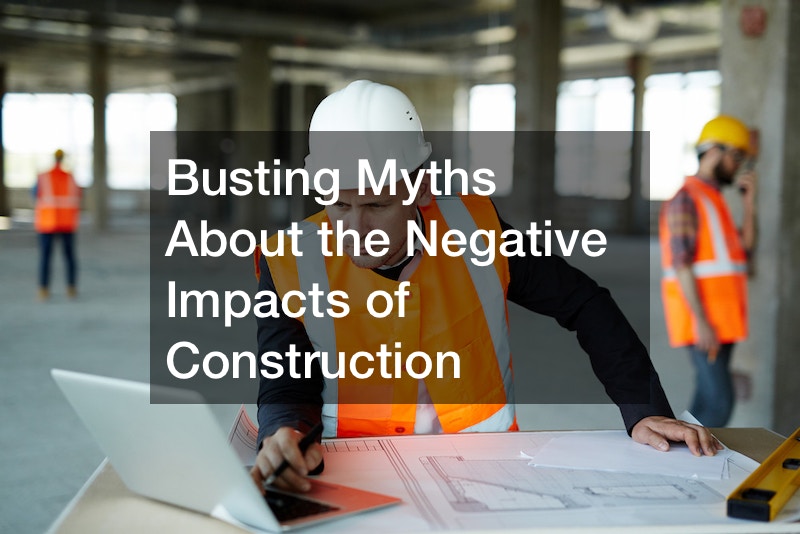
The building industry has faced criticism over the negative impacts of construction technology. This notion has spread from the government to aspiring construction workers or individuals interested in starting construction companies to parties wanting to build various structures for their personal or corporate use. The common negative aspects usually include high construction costs, insecurities about modern construction technology, the complexity of modern construction technologies, making them harder to use, lack of industry-specific designs for specialized industry construction needs, environmental degradation, which is blamed on modern construction practices, and construction design redundancy.
This article seeks to demystify these misleading beliefs concerning the negative impacts of construction technology. Let’s bust some myths if you’re interested in joining the construction workforce or building your structure.
Reliable Tech Doesn’t Have to Be Name-Brand

Here, the myth goes that if you want to be at the forefront of construction technology, you must engage a renowned construction name-brand for your project to be successful. For the aspiring construction worker, nothing could be further from the truth. For instance, you don’t have to use name-brand tech to conduct Viking appliance repairs.
Take, for instance, residential electrical contractors. In their case, it’s important to hone their skills at school and in practice. Your goal should be to render your expertise as second nature, thoroughly understanding and executing what’s required. In time, you will get the recognition you need to be or build your brand.
As a client, you shouldn’t be bogged down by the insistence of a world-class construction company claiming to be the only one who can meet or surpass your standards. To avoid the high charges such a company would demand, follow these steps: first, clearly understand the job you want done.
This isn’t to say you should enroll in an engineering course. All you need is an interest in knowing the basic requirements for your project and the corresponding sequence of events. Secondly, seek recommendations. You can source these from various sources, including friends or other companies that’ve completed similar projects. Check them up online and go through their previous clients’ reviews. Once you’ve identified a good fit, research what they’ve done in the past besides what you may already know. Check their turn-around times, rates, and character to see if they’re the kind of people you’re willing to work with. Verify their licenses and certifications. Finally, sign a detailed contract with the company of choice before commencing work.
Technology Can Be Secure
The widely-accepted myth here states that, at present, construction technologies are insecure and prone to hacking and other cyber threats. This one holds a big sway in convincing people of the negative impacts of construction technology. This should spark excitement if you’re interested in joining the construction workforce. It’s a niche area of expertise in the industry. If one can diligently take this up and delve deep into the science, it’s a fertile ground for invention and innovation. Modern construction tech security can be classified as a major branch of the construction industry. There are also issues in securities litigation where you may be found liable if you disclose inaccurate information about your company, securities fraud, or insider trading. Don’t be tempted to engage in these activities, even if you’re privy to sensitive company information.
For the client, this shouldn’t be a reason not to engage in a construction project. With measures taken for security, such as frequent software updates, data encryption for communication lines, and multi-factor authentication processes, there isn’t any cause to be worried. In addition, one can add more security options, including insurance, in case the unthinkable happens.
Technology Can Accommodate the User’s Needs

The myth here states that one of the negative impacts of construction technology is its complexity. For the aspiring construction worker, this is another game changer. If construction is the career you want, study for and master the areas considered difficult. This path sets you apart, inspires self-confidence, and guarantees a market for your skills. One can’t attain progress by avoiding the difficult parts. An example of an opportunity you can take advantage of is the application of an industrial insulation blanket. These are thermal insulators to keep in cool or hot temperatures.
For the client believing such claims, they really shouldn’t. The reality is that construction designs today are primarily user-centric. Borrowing from software developers and incorporating them, modern construction companies have optimized their processes to ensure the construction of intricate and highly intuitive interfaces and client-specific and simplified workflows. This is besides providing users with comprehensive training programs so they can easily leverage available technology to enhance their productivity and efficiency.
Tech Can Be Industry-Specific
The ongoing myth here is that, as part of the negative impact of construction technology, building styles have become too generic. They all look the same.
If you’re an aspiring builder, here’s an opportunity, especially if you’re still undergoing formal training or are an apprentice. The belief in this myth is a market indicator telling us that the market is ready for new and daring designs and that there’s a demand for genuine industry-specific designs. Let’s say a construction student, in the course of their studies, decides to concentrate on providing building solutions for specific industries like general health, space exploration, or simply middle-class residential homes. If they understand the nuances in that particular industry, revealing details often unseen to the average builder, with time, they’ll come up with something revolutionary, an appropriate construction design suited for a specific job. Or one could go the route of modifying what already exists, such as using a CAT cylinder to automate certain functions.
Conversely, clients interested in building industry-specific structures shouldn’t despair for lack of a design or designer. Construction companies are equipped for this purpose. The burden for the client here is communication. If you can lay out your idea for a particular design and it’s structurally sound, the contractor and his team can execute it perfectly. An example may be a dental office. With the guidance of the specialist in question, coupled with today’s construction technology, a dental office can be constructed to significantly reduce time wastage, optimize workflow, reduce anxiety, and ensure customer satisfaction.
Technology Can Be Restorative

The myth in this case, you must’ve heard, is that one of the negative impacts of construction technology is its wastefulness and the general harm it does to the environment. The myth highlights issues like the carbon print modern construction practices leave in their wake. The myth claims that this impacts the environment and global biomass.
The reality is that the construction industry is shifting towards adopting new environmentally friendly building techniques. To be fair, there are merits to this particular myth. However, to be even more meticulous, it must be said that emerging building trends today propose to prioritize environmental sensitivity, sustainability, and restoration.
If one was a college student training in building and construction, this is one area they should consider majoring in to reduce the negative impacts of construction technology. The fact that a large segment of the market holds some of these myths to be true provides market data that can inform a construction worker in training on the best direction to take. Just like the two last myths, this one can also catapult the career of an aspiring, daring innovator.
This study area opens many options to consider and test. The best approach for a student pursuing this is first to understand the environment as a whole and how it works. This includes favored ways of maintaining and restoring the environment and studies of ideal environmental elements one can use in construction to meet this end. Processes like clamshell dredging should be made more efficient, and practices like reverse osmosis system should be discarded.
The construction industry offers several solutions for the concerned client bent on keeping their carbon footprint low. From energy-efficient systems to green building materials, greenhouse gas absorption materials to proper construction waste management, the option to build ‘clean’ is readily available. Existing construction technologies can monitor environmental metrics, including IoT devices and smart sensors. They monitor and mitigate issues in construction that can be regarded as environmentally harmful.
Tech Can Benefit Your Existing Home
Another myth showing the negative impacts of construction technology states that construction only refers to new projects, that is, projects starting from the ground up. Well, this is not true.
For an aspiring future construction worker, part of your training will include renovating and reinventing constructed buildings. In this case, the building’s old, degraded, or outdated parts are removed and replaced by newer and stronger parts. This could be the doors, floor, ceilings, and sometimes walls. Other necessary work here may be in the form of repair jobs.
This myth may not be widely held because the market suggests otherwise. There are a lot of companies and individuals who’ve taken this up as a business. They buy old, dilapidated buildings at a discounted price, restore them, and then return them to the market for a profit. This is known as flipping houses, a business model that has been around for many years. The point here is that construction is not only feasible on existing buildings, but one can turn a profit in the process as well.
Technology Can Be Astonishing

This audacious myth states that one of the negative impacts of construction technology is that building designs look the same, that building designs and their respective facades are mundane, lacking innovation or inspiration. This, too, is an untrue statement. Anyone who’s been keeping up with modern construction trends can attest to the invalidity of this claim. Among those willing to disagree with this claim are construction workers and construction students.
Studies and trends in the industry are increasingly leveraging technology, as attested by groundbreaking advancements such as 3D printing of entire buildings and the incorporation of robotics and artificial intelligence. The construction scene has witnessed an unprecedented leap in construction technologies, and to claim that all buildings look the same is an insult to these technologies.
Aspiring construction workers are spoilt for choice here. You can incorporate recycling techniques into your work, like using a glass to sand crusher to recover sand from glass. This gives off an intriguing end product. Lastly, burnishing is another way of making seemingly simple designs into exquisitely finished works. This makes the finished surface very appealing, hard, and resistant.
For the adventurous client interested in constructing their bespoke architectural masterpiece, there’s a lot of fun here. All one requires is a clear picture of what you want to achieve and the right team to execute it. With that, you can build unique structures never seen before.
You can also bring to life historical edifices such as the Pantheon or the Colosseum through modern technology. Imagine walking into a historical reconstruction of one of the ancient Greek arenas, in your mind almost hearing the shrieks from attendees baying for blood! If you can take a minute to search the internet for unique architecture, you will be astounded at what you find. Construction technology exists that’ll boggle your mind.
Construction Is for College Dropouts
This is another baseless myth discounted by the numerous well-paid career opportunities in the construction industry, some of which are for degree-level employees. Besides, there are educational programs in colleges and universities for construction work. In any case, one needs a high level of expertise and skill to manage multi-million dollar projects.
This article aims to demystify long-held myths surrounding the construction industry. The belief in the negative impacts of construction technology today isn’t from a place of information but ignorance. By demystifying the myths surrounding the negative impacts of construction technology, the market is freed up, and design and innovative creativity is unleashed.
Governments can fund their chemists to develop new versatile, feasible, and environmentally friendly building materials that rejuvenate the environment. Construction companies can explore building techniques that increase efficiency in the building process and its utility. This sounds like the vibrant construction industry required to forge the path to a new construction age devoid of myths and unnecessary conjecture.



